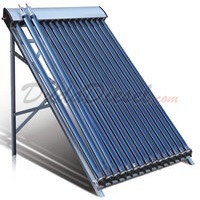@Gumby I am working on that right now for the new home.
The current idea is a simple thermal storage mass.
https://en.wikipedia.org/wiki/Seasonal_thermal_energy_storage
Scroll down to GIITS or the pit storage descriptions.
I got a quote for insulation yesterday.
My tentatlve plan is to build a thermal mass from a mix of existing soils and possibly some imported sands, measuring 12' wide by 6' high by 60' -ish long.
That's 120 cubic yards, and if I build it with high moisture content the mass is ~150,000 kg.
soil has a heat capacity of ~1000 joules per kg per degree C.
using a range of 40C to 65 C the mass has about 3.5 million BTU of storage, which is 160 hours times the the Manual J heat requirements for our home.
That assumes no input and the
vacuum tube solar collectors make heat year round if they get sun.
I have several months to fine tune the requirements. The house is being built with chases from the basement equipment room to the roof to allow addition of more panels for scalability.
Floor hydronics run at a maximum temperature of 40C. When the mass is > 40C a simple mixing valve will condition the fluid as it goes into the hydronics.


